Comparative Radiation Response of GaN and Ga2O3 Exposed to Ground-Level Neutrons
Abstract
:1. Introduction
2. Materials and Methods
2.1. Materials Properties
2.2. Atmospheric Neutron Source
2.3. Direct Calculation of the Number of Interactions
2.4. Geant4 Simulation Details
3. Results
3.1. Number of Interactions
3.2. Type of Interactions
3.3. Secondary Products
4. Discussion
5. Conclusions
Author Contributions
Funding
Data Availability Statement
Conflicts of Interest
References
- Tsao, J.Y.; Chowdhury, S.; Hollis, M.A.; Jena, D.; Johnson, N.M.; Jones, K.A.; Kaplar, R.J.; Rajan, S.; Van de Walle, C.G.; Bellotti, E.; et al. Ultrawide-Bandgap Semiconductors: Research Opportunities and Challenges. Adv. Electron. Mater. 2018, 4, 1600501. [Google Scholar] [CrossRef]
- Dahiya, S.; Kaur, D.; Ghosh, A.; Kumar, M. A strategic review on gallium oxide based power electronics: Recent progress and future prospects. Mater. Today Commun. 2022, 33, 104244. [Google Scholar]
- Xu, M.; Wang, D.; Fu, K.; Mudiyanselage, D.H.; Fu, H.; Zhao, Y. A review of ultrawide bandgap materials: Properties, synthesis and devices. Oxf. Open Mater. Sci. 2022, 2, itac004. [Google Scholar] [CrossRef]
- Ding, X.; Zhou, Y.; Cheng, J. A review of gallium nitride power device and its applications in motor drive. CES Trans. Electr. Mach. Syst. 2019, 3, 54–64. [Google Scholar] [CrossRef]
- Udabe, A.; Baraia-Etxaburu, I.; Diez, D.G. Gallium Nitride Power Devices: A State of the Art Review. IEEE Access 2023, 11, 48628–48650. [Google Scholar] [CrossRef]
- Kumar, S.; Reshi, B.A.; Varma, R. Comparison of Silicon, Germanium, Gallium Nitride, and Diamond for using as a detector material in experimental high energy physics. Results Phys. 2018, 11, 461–474. [Google Scholar] [CrossRef]
- Wang, J.; Mulligan, P.; Brillson, L.; Cao, L.R. Review of using gallium nitride for ionizing radiation detection. Appl. Phys. Rev. 2015, 2, 031102. [Google Scholar] [CrossRef]
- Pearton, S.J.; Ren, F.; Patrick, E.; Law, M.E.; Polyakov, A.Y. Review—Ionizing Radiation Damage Effects on GaN Devices. ECS J. Solid State Sci. Technol. 2016, 5, Q35–Q60. [Google Scholar] [CrossRef]
- Zhang, Y.; Dadgar, A.; Palacios, T. Gallium nitride vertical power devices on foreign substrates: A review and outlook. J. Phys. D Appl. Phys. 2018, 51, 273001. [Google Scholar] [CrossRef]
- Zhou, C.; Melton, A.G.; Burgett, E.; Hertel, N.; Ferguson, I.T. Neutron detection performance of gallium nitride based semiconductors. Sci. Rep. 2019, 9, 17551. [Google Scholar] [CrossRef]
- Qiao, R.; Zhang, H.; Zhao, S.; Yuan, L.; Jia, R.; Peng, B.; Zhang, Y. A state-of-art review on gallium oxide field-effect transistors. J. Phys. D Appl. Phys. 2022, 55, 383003. [Google Scholar] [CrossRef]
- Zhang, M.; Liu, Z.; Yang, L.; Yao, J.; Chen, J.; Zhang, J.; Wei, W.; Guo, Y.; Tang, W. β-Ga2O3-Based Power Devices: A Concise Review. Crystals 2022, 12, 406. [Google Scholar] [CrossRef]
- Xue, H.; He, Q.; Jian, G.; Long, S.; Pang, T.; Liu, M. An Overview of the Ultrawide Bandgap Ga2O3 Semiconductor-Based Schottky Barrier Diode for Power Electronics Application. Nanoscale Res. Lett. 2018, 13, 290. [Google Scholar] [CrossRef] [PubMed]
- Pearton, S.; Aitkaliyeva, A.; Xian, M.; Ren, F.; Khachatrian, A.; Ildefonsorosa, A.; Islam, Z.; Rasel, M.; Haque, A.; Polyakov, A.; et al. Review—Radiation Damage in Wide and Ultra-Wide Bandgap Semiconductors. ECS J. Solid State Sci. Technol. 2021, 10, 055008. [Google Scholar] [CrossRef]
- Autran, J.L.; Munteanu, D. Atmospheric Neutron Radiation Response of III-V Binary Compound Semiconductors. IEEE Trans. Nucl. Sci. 2020, 67, 1428–1435. [Google Scholar] [CrossRef]
- Jasica, M.J.; Wampler, W.R.; Vizkelethy, G.; Hehr, B.D.; Bielejec, E.S. Photocurrent from Single Collision 14-MeV Neutrons in GaN and GaAs. IEEE Trans. Nucl. Sci. 2020, 67, 221–227. [Google Scholar] [CrossRef]
- Munteanu, D.; Autran, J.L. Terrestrial neutron-induced single events in GaN. Microelectron. Reliabil. 2019, 100–101, 113357. [Google Scholar] [CrossRef]
- Gao, H.; Ahsanullah, D.; Baumann, R.; Gnade, B. A Study of Neutron Induced Single-Event Damage in AlGaN/GaN HEMTs. In Proceedings of the 2022 IEEE Radiation Effects Data Workshop (REDW), Provo, UT, USA, 12–18 July 2022; pp. 1–6. [Google Scholar]
- Mirkhosravi, F.; Rashidi, A.; Elshafiey, A.T.; Gallagher, J.; Abedi, Z.; Ahn, K.; Lintereur, A.; Mace, E.K.; Scarpulla, M.A.; Feezell, D. Effects of fast and thermal neutron irradiation on Ga-polar and N-polar GaN diodes. J. Appl. Phys. 2023, 133, 015704. [Google Scholar] [CrossRef]
- Lambert, D.; Parize, J.; Richard, N.; Raine, M.; Duhamel, O.; Marcandella, C.; Losquin, A.; Hemeryck, A.; Inguimbert, C.; Paillet, P. Neutron Displacement Damage cross Section in GaN: Numerical Evaluations and Differences with Si. IEEE Trans. Nucl. Sci. 2023, 70, 1870–1877. [Google Scholar] [CrossRef]
- Yu, C.; Guo, H.; Liu, Y.; Wu, X.; Zhang, L.; Tan, X.; Han, Y.; Ren, L. Simulation study on single-event burnout in field-plated Ga2O3 MOSFETs. Microelectron. Reliabil. 2023, 149, 115227. [Google Scholar] [CrossRef]
- Zhang, J.; Dong, P.; Dang, K.; Zhang, Y.; Yan, Q.; Xiang, H.; Su, J.; Liu, Z.; Si, M.; Gao, J.; et al. Ultra-wide bandgap semiconductor Ga2O3 power diodes. Nat. Commun. 2022, 13, 3900. [Google Scholar] [CrossRef]
- Berthet, F.; Petitdidier, S.; Guhel, Y.; Trolet, J.L.; Mary, P.; Gaquière, C.; Boudart, B. Influence of neutron irradiation on electron traps existing in GaN-based transistors. IEEE Trans. Nucl. Sci. 2016, 63, 1918–1926. [Google Scholar] [CrossRef]
- Butler, P.A.; Uren, M.J.; Lambert, B.; Kuball, M. Neutron irradiation impact on AlGaN/GaN HEMT switching transients. IEEE Trans. Nucl. Sci. 2018, 65, 2862–2869. [Google Scholar] [CrossRef]
- Gao, H.; Narayan, R.T.; Gnade, B.; Baumann, R. Characterization and simulation of terrestrial neutron induced destructive single-event effects in Gallium Nitride (GaN) power devices. IEEE Trans. Nucl. Sci. 2023, 70, 2432–2441. [Google Scholar] [CrossRef]
- Munteanu, D.; Autran, J.L. Susceptibility of Group-IV and III-V Semiconductor-based Electronics to Atmospheric Neutrons Explored by Geant4 Numerical Simulations. In Numerical Simulations; Rao, S., Ed.; IntechOpen: London, UK, 2018; pp. 117–134. [Google Scholar]
- Autran, J.L.; Munteanu, D. Radiation Response of Group-IV and III-V Semiconductors Subjected to D–D and D–T Fusion Neutrons. In New Advances in Semiconductors; Cavalheiro, A.A., Ed.; IntechOpen: London, UK, 2022; pp. 1–21. [Google Scholar]
- Agostinelli, S.; Allison, J.; Amako, K.; Apostolakis, J.; Araujo, H.; Arce, P.; Asai, M.; Axen, D.; Banerjee, S.; Barrand, G.; et al. Geant4—A simulation toolkit. Nucl. Instrum. Meth. A 2003, 506, 250–303. [Google Scholar] [CrossRef]
- Allison, J.; Amako, K.; Apostolakis, J.; Araujo, H.; Arce Dubois, P.; Asai, M.; Barrand, G.; Capra, R.; Chauvie, S.; Chytraceket, R.; et al. Geant4 developments and applications. IEEE Trans. Nucl. Sci. 2006, 53, 270–278. [Google Scholar] [CrossRef]
- Allison, J.; Amako, K.; Apostolakis, J.; Arce, P.; Asai, M.; Aso, T.; Bagli, E.; Bagulya, A.; Banerjee, S.; Barrand, G.; et al. Recent developments in Geant4. Nucl. Instrum. Meth. A 2016, 835, 186–225. [Google Scholar] [CrossRef]
- Coffie, R.L. High Power High Frequency Transistors: A Material’s Perspective. In High-Frequency GaN Electronic Devices; Fay, P., Jena, D., Maki, P., Eds.; Springer International Publishing: Cham, Switzerland, 2020; pp. 5–41. [Google Scholar]
- Yakimov, E.B.; Polyakov, A.Y.; Shchemerov, I.V.; Smirnov, N.B.; Vasilev, A.A.; Vergeles, P.S.; Yakimov, E.E.; Chernykh, A.V.; Ren, F.; Pearton, S.J. Experimental estimation of electron–hole pair creation energy in β-Ga2O3. Appl. Phys. Lett. 2021, 118, 202106. [Google Scholar] [CrossRef]
- Gordon, M.S.; Goldhagen, P.; Rodbell, K.P.; Zabel, T.H.; Tang, H.H.K.; Clem, J.M.; Bailey, P. Measurement of the Flux and Energy Spectrum of Cosmic-Ray Induced Neutrons on the Ground. IEEE Trans. Nucl. Sci. 2004, 51, 3427–3434. [Google Scholar] [CrossRef]
- Goldhagen, P. Cosmic-Ray Neutrons on the Ground and in the Atmosphere. MRS Bull. 2003, 28, 131–135. [Google Scholar] [CrossRef]
- Autran, J.L.; Munteanu, D. Soft Errors: From Particles to Circuits; Taylor & Francis/CRC Press: Boca Raton, FL, USA, 2015. [Google Scholar]
- Brown, D.A.; Chadwick, M.B.; Capote, R.; Kahler, A.C.; Trkov, A.; Herman, M.W.; Sonzogni, A.A.; Danon, Y.; Carlson, A.D.; Dunn, M.; et al. ENDF/B-VIII.0: The 8th Major Release of the Nuclear Reaction Data Library with CIELO-project Cross Sections, New Standards and Thermal Scattering Data. Nucl. Data Sheets 2018, 148, 1–142. [Google Scholar] [CrossRef]
- Chadwick, M.B.; Herman, M.W.; Obložinský, P.; Dunn, M.E.; Danon, Y.; Kahler, A.C.; Smith, D.L.; Pritychenko, B.; Arbanas, G.; Arcilla, R.; et al. ENDF/B-VII.1 Nuclear Data for Science and Technology: Cross Sections, Covariances, Fission Product Yields and Decay Data. Nucl. Data Sheets 2011, 112, 2887–2996. [Google Scholar] [CrossRef]
- Shibata, K.; Iwamoto, O.; Nakagawa, T.; Iwamoto, N.; Ichihara, A.; Kunieda, S.; Chiba, S.; Furutaka, K.; Oyuka, N.; Ohsawa, T.; et al. JENDL-4.0: A New Library for Nuclear Science and Engineering. J. Nucl. Sci. Technol. 2011, 48, 1–30. [Google Scholar] [CrossRef]
- Geant4 General Particle Source (GPS). Available online: https://www.fe.infn.it/u/paterno/Geant4_tutorial/slides_further/GPS/GPS_manual.pdf (accessed on 20 November 2023).
- Munteanu, D.; Autran, J.L. Modeling and Simulation of Single-Event Effects in Digital Devices and ICs. IEEE Trans. Nucl. Sci. 2008, 55, 1854–1878. [Google Scholar] [CrossRef]
- Coronetti, A.; Alía, R.G.; Lucsanyi, D.; Letiche, M.; Kastriotou, K.; Cazzaniga, C.; Frost, C.D.; Saigné, F. An Analysis of the Significance of the 14N(n,p)14C Reaction for Single-Event Upsets Induced by Thermal Neutrons in SRAMs. IEEE Trans. Nucl. Sci. 2023, 70, 1634–1642. [Google Scholar] [CrossRef]
- JESD89B; Measurement and Reporting of Alpha Particle and Terrestrial Cosmic Ray-Induced Soft Errors in Semiconductor Devices. JEDEC: Arlington, VA, USA, 2021.
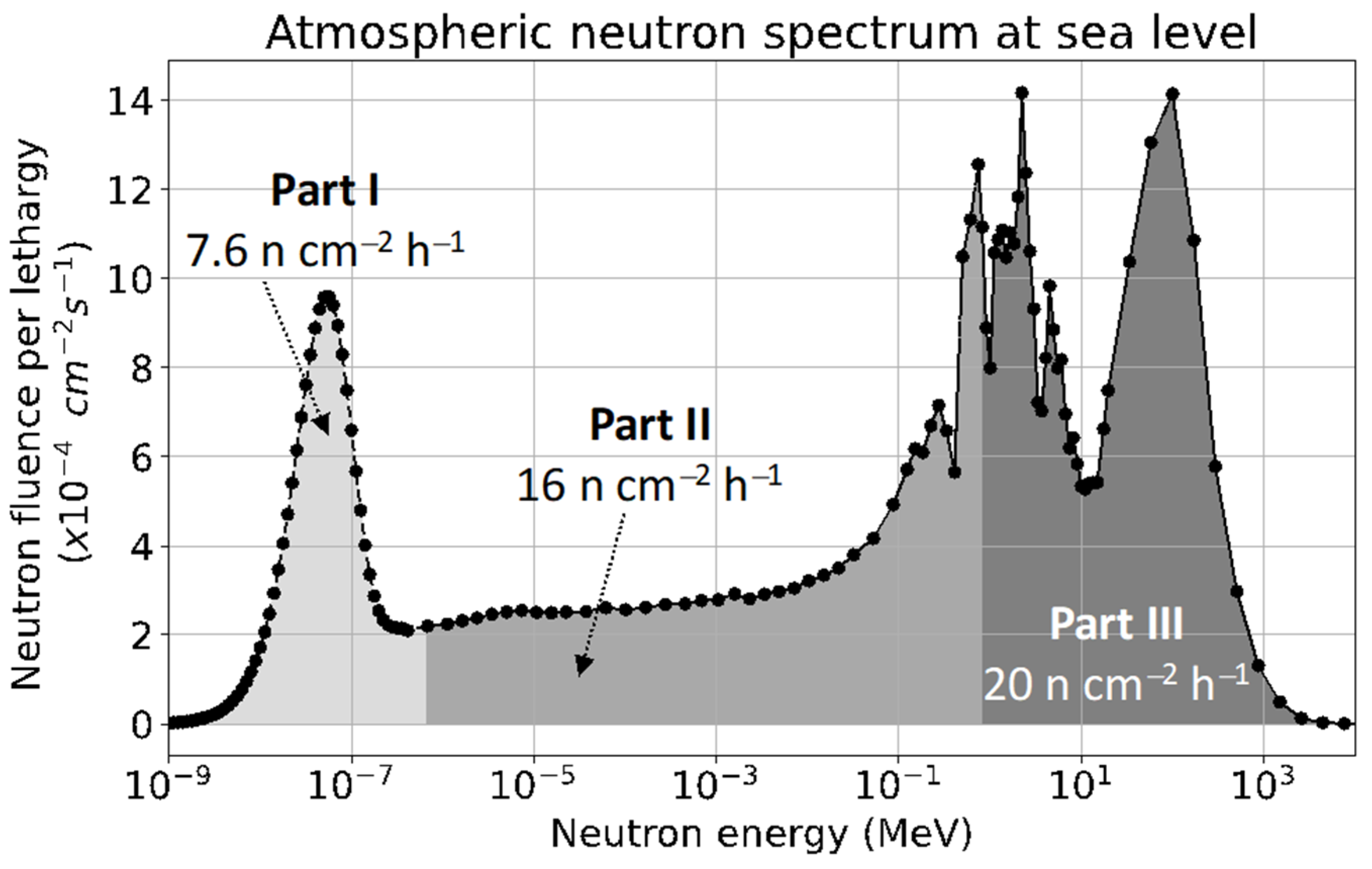
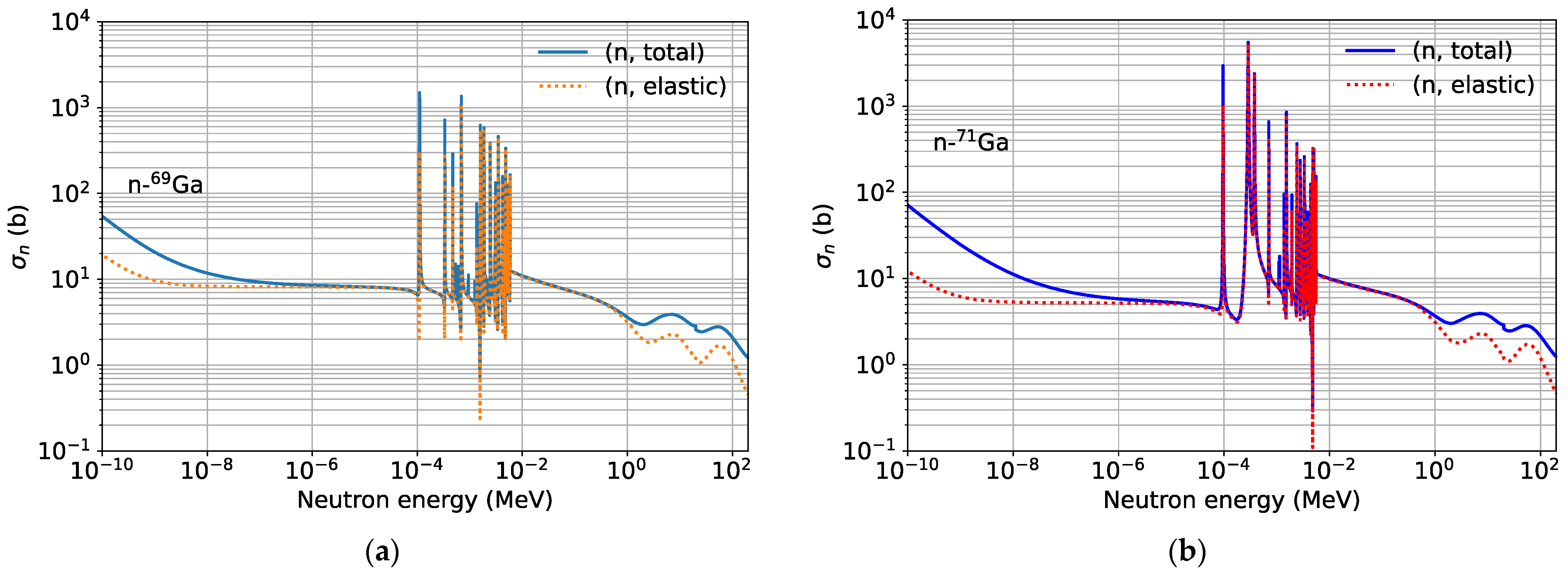

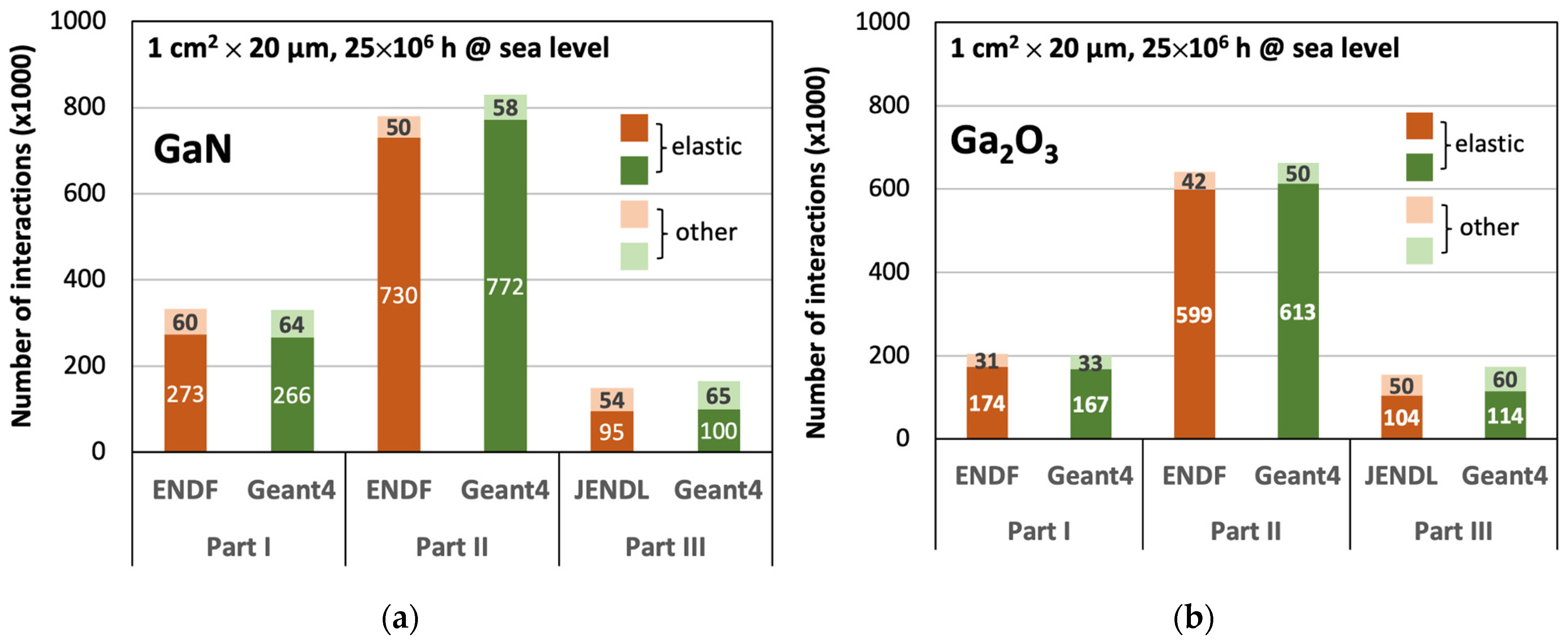
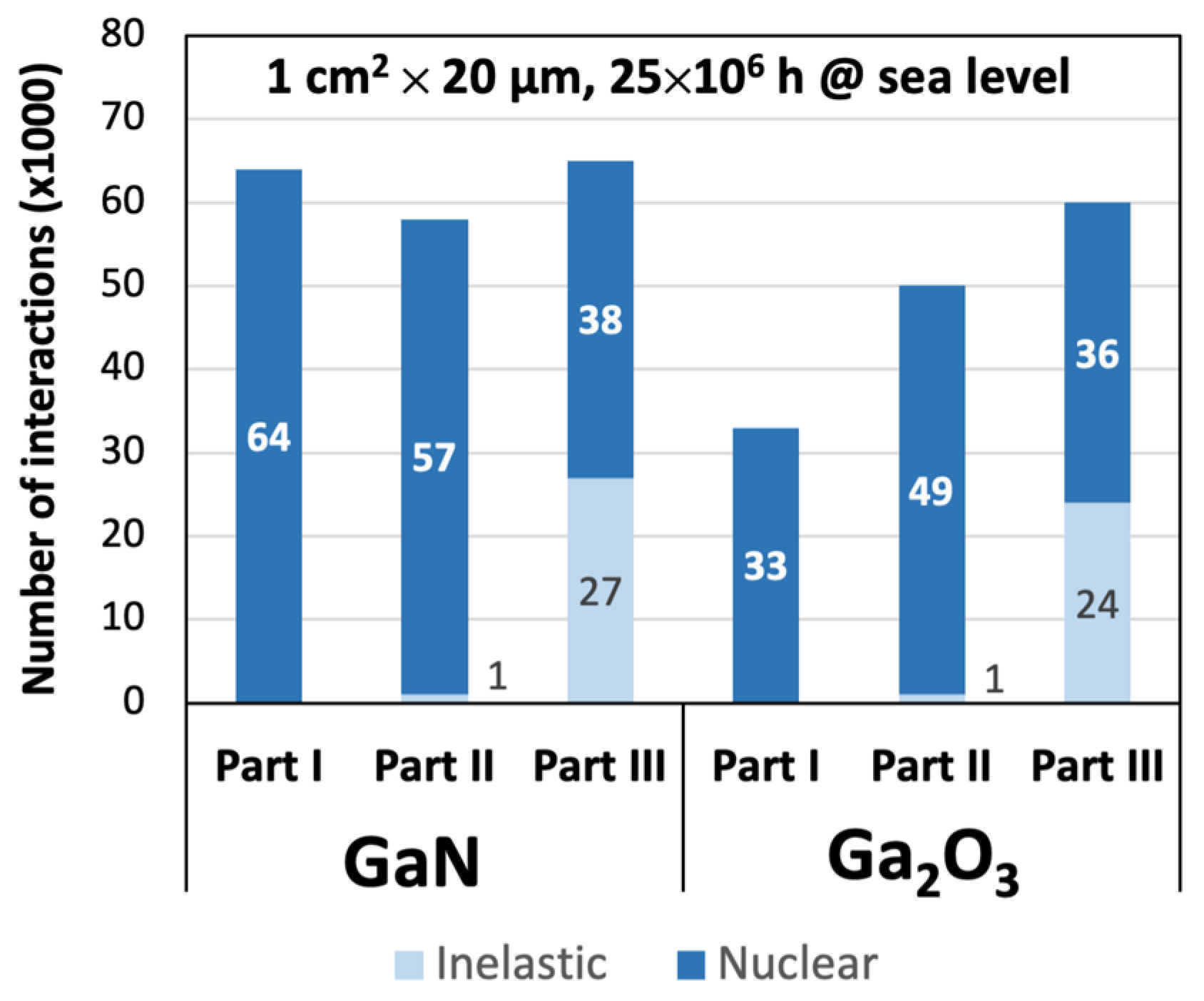



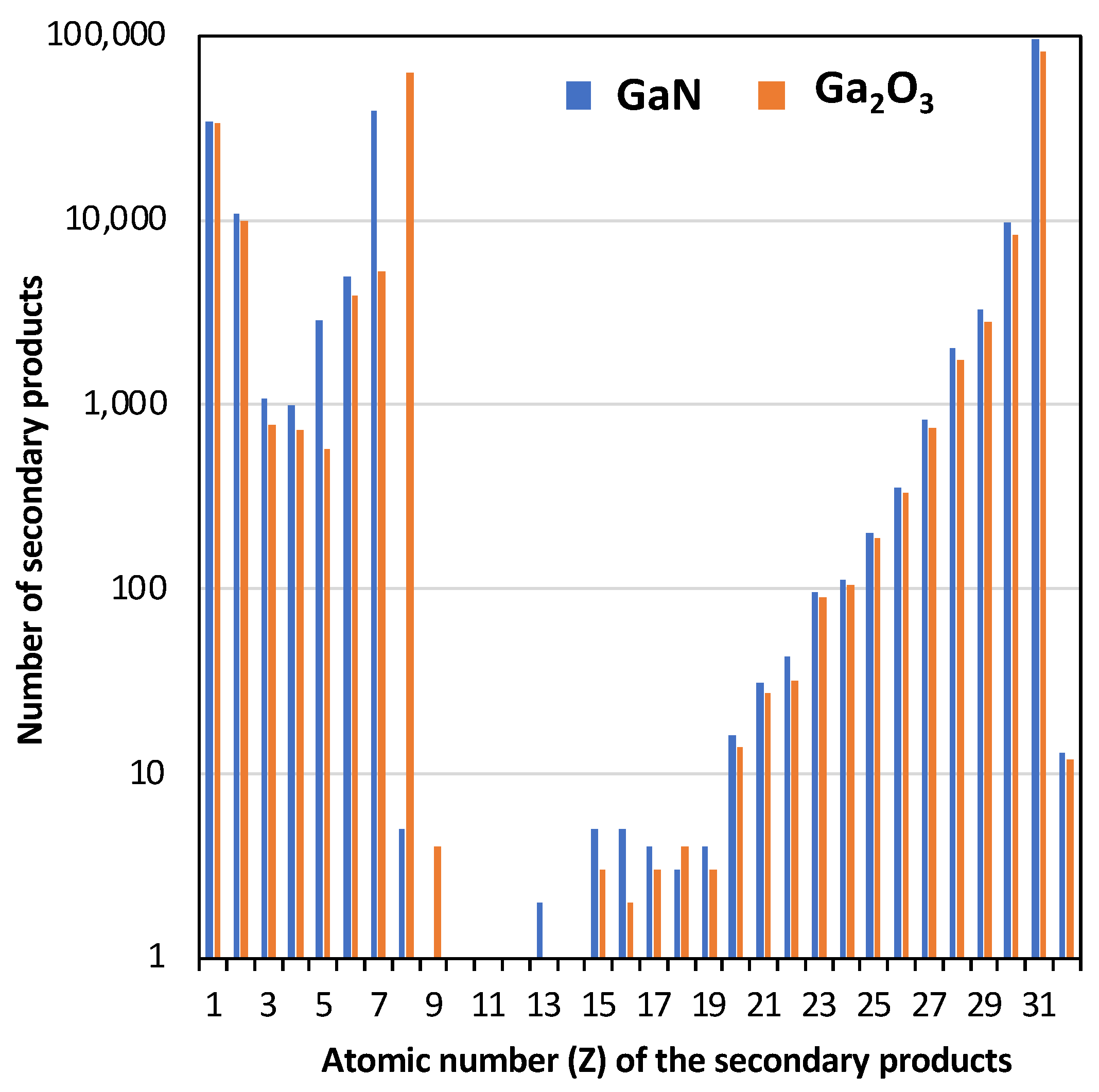
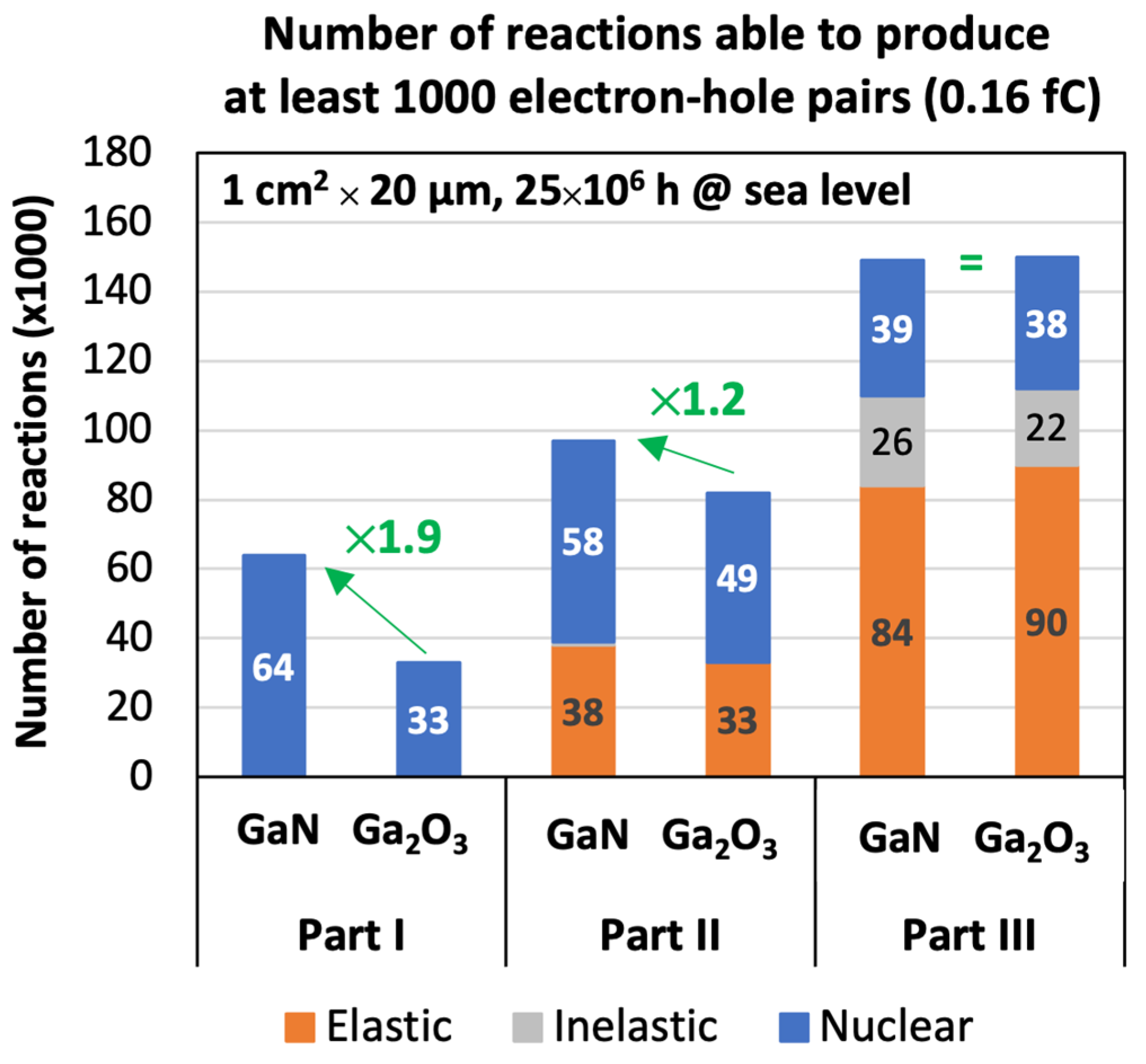
| Properties (300 K) | β-Ga2O3 | GaN |
|---|---|---|
| Bandgap (eV) | 4.6–4.9 | 3.39 |
| Density (g/cm3) | 5.96 | 6.15 |
| Atoms (cm−3) | 9.45 × 1022 | 8.85 × 1022 |
| εe,h (eV) 1 | 15.6 | 8.9 |
| Reaction | Part I | Part II | Part III | |||
|---|---|---|---|---|---|---|
| GaN | Ga2O3 | GaN | Ga2O3 | GaN | Ga2O3 | |
| 69Ga elastic | 68 | 58 | 182 | 158 | 38 | 33 |
| 71Ga elastic | 27 | 23 | 320 | 278 | 25 | 22 |
| 14N elastic | 171 | - | 270 | - | 37 | - |
| 16O elastic | - | 86 | - | 177 | - | 59 |
| 69Ga(n,γ)70Ga | 14 | 12 | 25 | 22 | 1 | 1 |
| 71Ga(n,γ)72Ga | 25 | 21 | 31 | 27 | 0 | 0 |
| 14N(n,γ)15N | 1 | - | 0 | - | 0 | - |
| 14N(n,p)14C | 24 | - | 1 | - | 1 | - |
Disclaimer/Publisher’s Note: The statements, opinions and data contained in all publications are solely those of the individual author(s) and contributor(s) and not of MDPI and/or the editor(s). MDPI and/or the editor(s) disclaim responsibility for any injury to people or property resulting from any ideas, methods, instructions or products referred to in the content. |
© 2024 by the authors. Licensee MDPI, Basel, Switzerland. This article is an open access article distributed under the terms and conditions of the Creative Commons Attribution (CC BY) license (https://creativecommons.org/licenses/by/4.0/).
Share and Cite
Autran, J.-L.; Munteanu, D. Comparative Radiation Response of GaN and Ga2O3 Exposed to Ground-Level Neutrons. Crystals 2024, 14, 128. https://doi.org/10.3390/cryst14020128
Autran J-L, Munteanu D. Comparative Radiation Response of GaN and Ga2O3 Exposed to Ground-Level Neutrons. Crystals. 2024; 14(2):128. https://doi.org/10.3390/cryst14020128
Chicago/Turabian StyleAutran, Jean-Luc, and Daniela Munteanu. 2024. "Comparative Radiation Response of GaN and Ga2O3 Exposed to Ground-Level Neutrons" Crystals 14, no. 2: 128. https://doi.org/10.3390/cryst14020128





